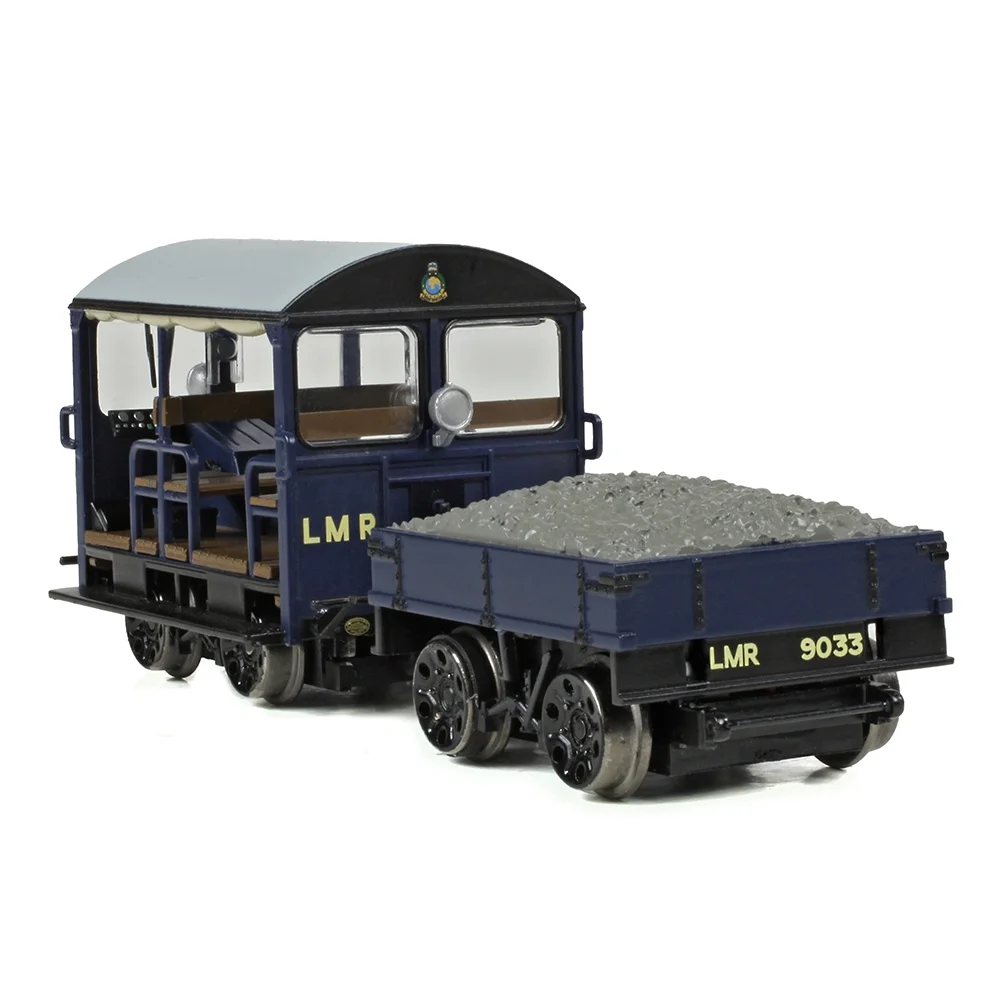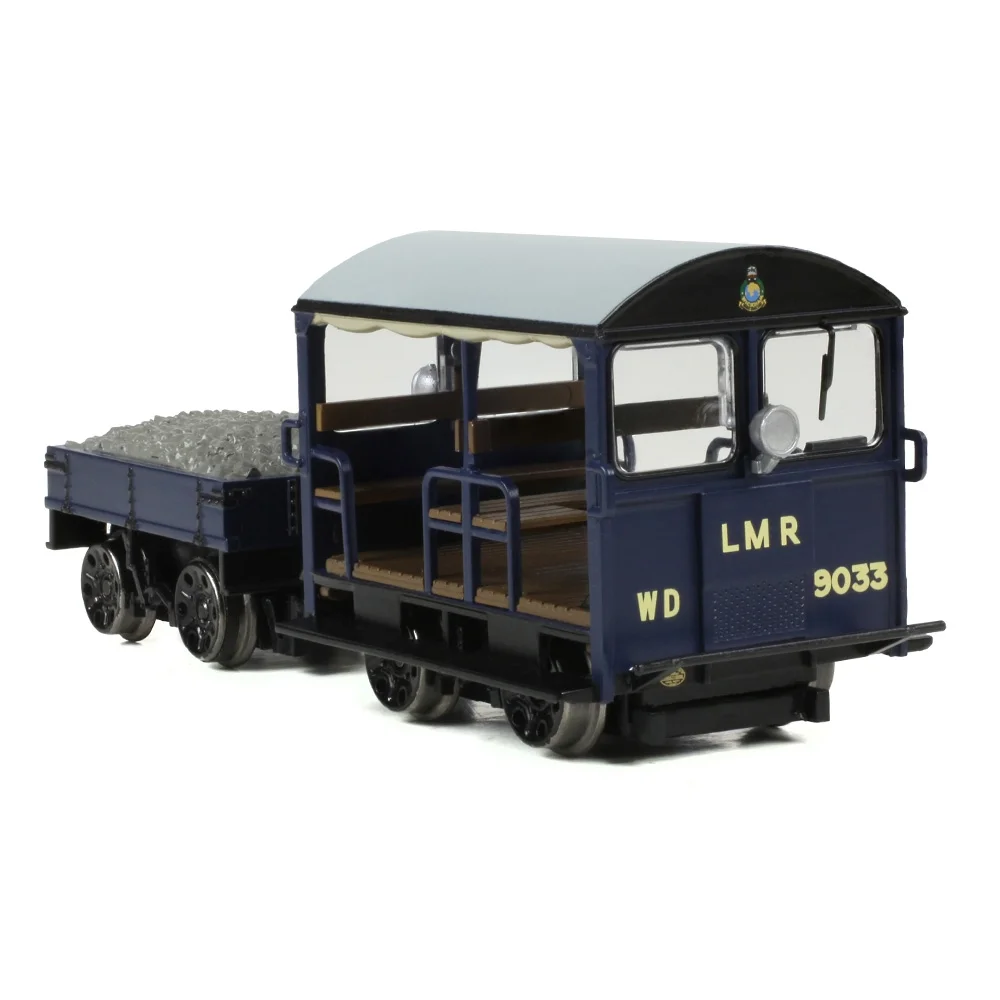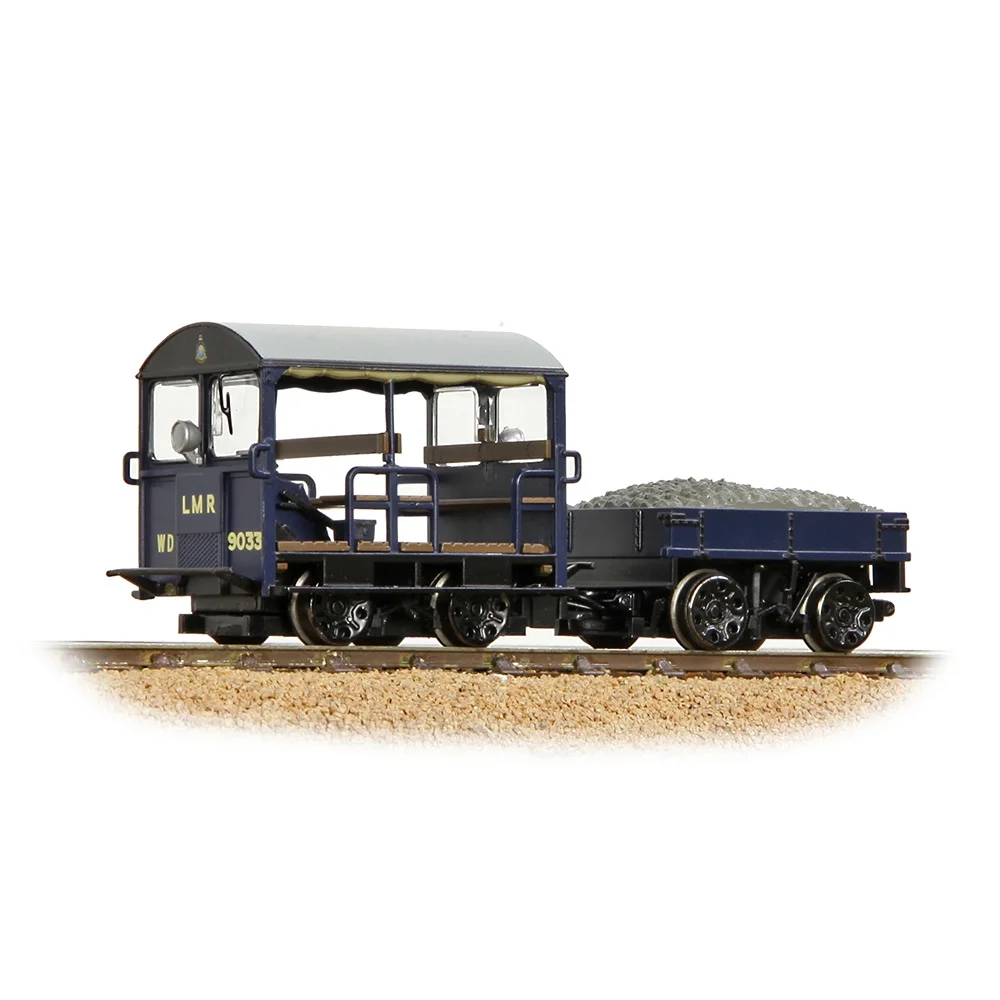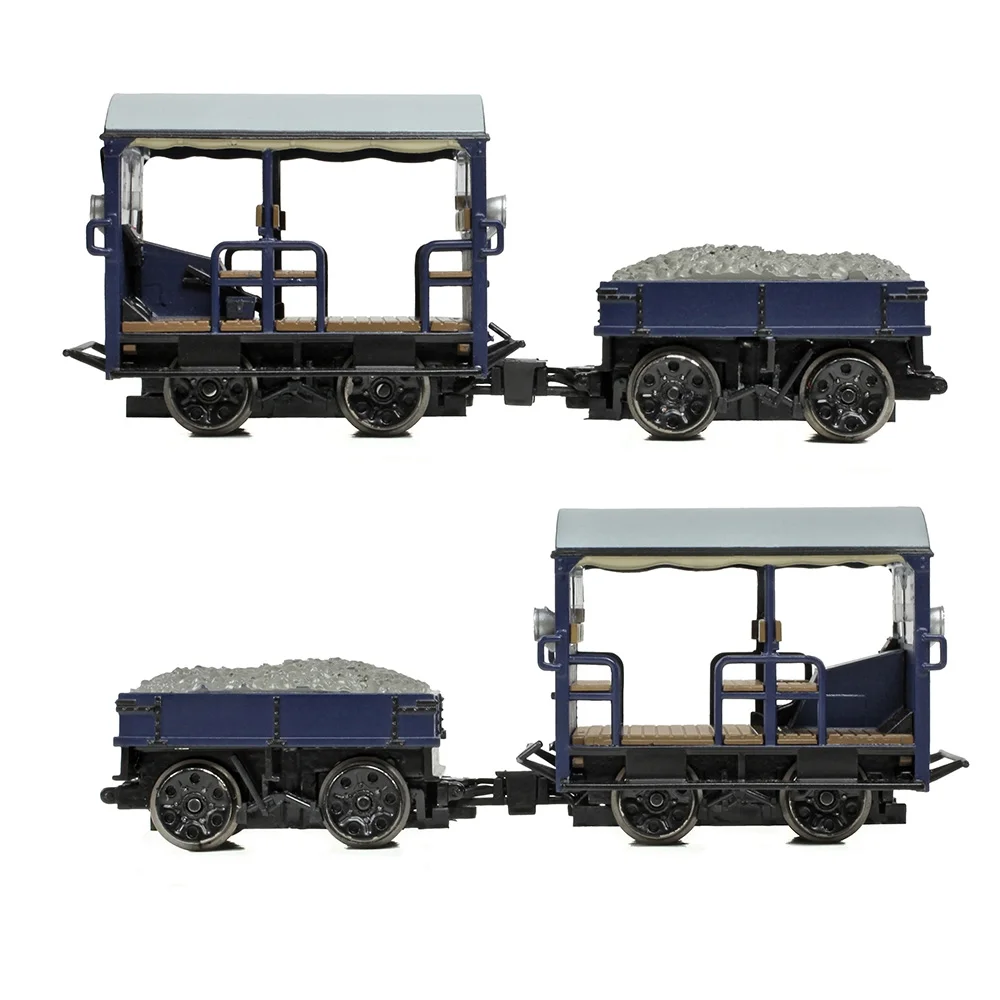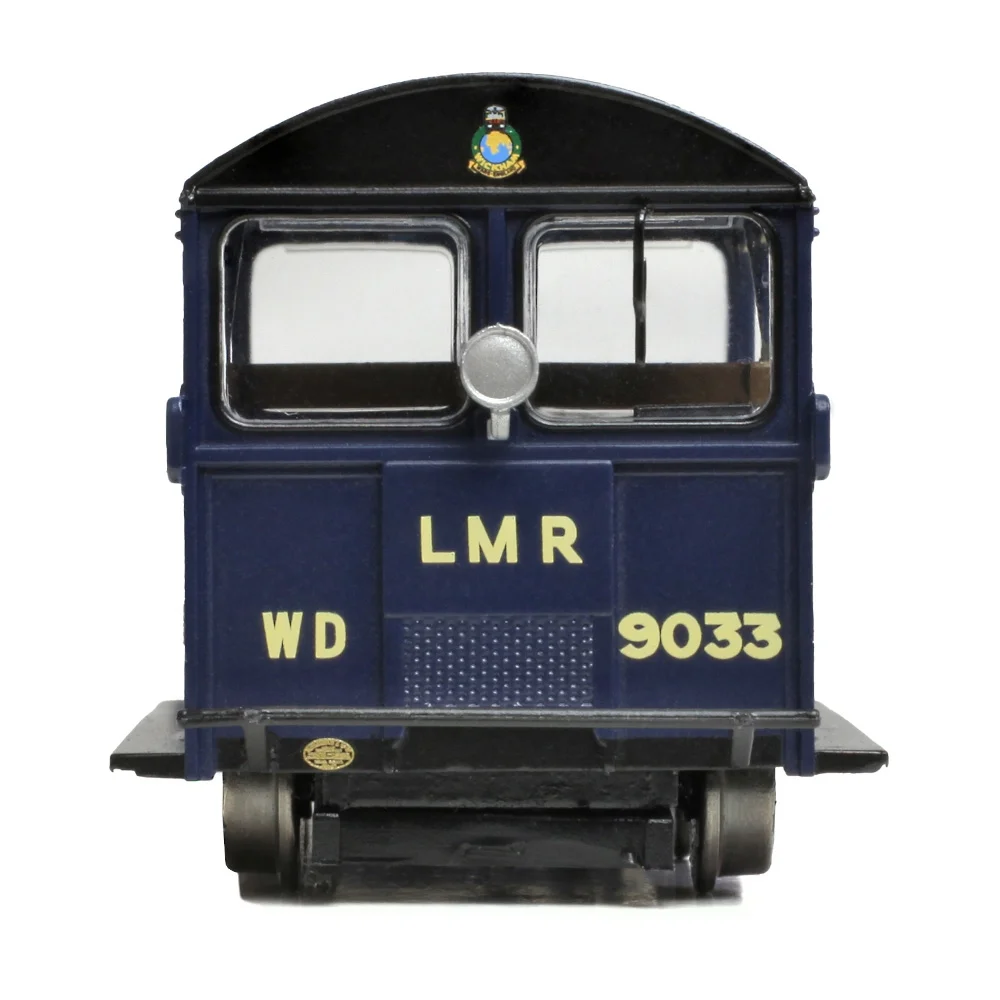Bachmann 32-995
Wickham Trolley WD9033 Longmoor Military Railway Blue
Tooling
The Bachmann Branchline OO-scale Wickham Type 27 Trolley tooling was introduced in 2017. Based on the diminutive track-inspection trolley built by D. Wickham & Co. from the 1940s, Bachmann’s model captures the charm and utility of the prototype, offering modellers a motorised, highly detailed departmental vehicle for their layouts.
Tooling Features
- Scale & Construction: OO gauge (1:76 scale), compact body approximately 76 mm long, running on small-diameter wheels with accurate pattern and profile, including separate brake detail.
- Body Detailing: Intricately moulded cab with glazed windows, separate windscreen wiper, structural handrails, and replicated rolled-up weather sheeting on the roof edge.
- Trailer Configuration: Semi-permanently coupled trailer featuring a ballast/spoil load—used to conceal mechanism—and a die-cast metal chassis with metal-axle bearings.
- Couplings & Pickup: Semi-permanent coupling links trolley and trailer, enabling eight-wheel power pickups for better electrical contact.
- Traction: Driven axle fitted with traction tyres; coreless motor in die-cast gearbox ensures smooth, reliable low-speed operation.
Mechanical & Electrical
- Drive System: Coreless motor mounted inside trailer, powering one axle through metal gears within a die-cast gearbox.
- Minimum Radius: Capable of navigating tight pointwork and sharp curves effortlessly—ideal for intricate layouts.
- Weighting: Substantial heft provided by ballast load in trailer, aiding traction and balance without compromising scale appearance.
- Lighting: Static head—and tail—lights included for realism (non-functional in standard models).
- Running-In Requirement: Bachmann recommends approximately one hour of running-in (both directions, no load) to settle pickups and gearing.
DCC Capability
- Identified as DCC-compatible, though models are supplied without a decoder socket. Official guidance warns against running it directly on DCC systems due to risk of motor damage.
- Enthusiast conversions demonstrate successful fitting of micro-decoders (e.g., ESU LokPilot micro, CT Electronik/DCX77Z, Digitrax DZ126T) concealed within the ballast load of the trailer. Modifications include cutting a small access opening and re-covering with modelled ballast or tool containers.
Liveries Produced
- BR Dept’l Olive (1955–1985)
- BR Maroon (1956–1970)
- BR Engineers Yellow (1970–1994), available in standard and “wasp-stripe” variants, and also in BR Engineers Green
- Special edition: LMR Blue WD9033 (preservation roster suffix)
Media & Reviews
- Hornby Magazine / Key Model World (2016–17): Featured operational demonstrations on test tracks and considered it one of the most detailed and effective small mechanised RTR models in OO scale.
- YouTube & ModelRail Forums: ModelRailroadForums dubbed it “Bachmann’s smallest train?”, praising the finesse visible in unboxing and the running performance. Review videos highlight quiet, confident traction and excellent pointwork handling.
- RMweb & Platform1mrc: Threads and “how-to” guides document the DCC conversion process—offering step-by-step advice on decoder choice, placement, and concealment tactics to maintain scale appearance.
- User Feedback: Enthusiasts commend the tooling for exceptional detail and smooth running at low speeds. Conversion reports note the challenge but also the achievement of installing DCC decoders in such a compact space.
Interesting Facts
- Widely acclaimed as one of the smallest ready-to-run (RTR) powered OO models, with the trolley body smaller in footprint than a 50p coin.
- The trailer’s ballast load serves dual purpose—functionally weighting the model and practically concealing mechanisms such as die-cast gearbox and pickup wiring.
- Liveried versions like WD9033 LMR Blue reference a preserved prototype used in the 1966 film “The Great St. Trains Robbery.”
- Model proven reliable for extended operation, highly favoured by modellers for adding operational realism with minimal layout footprint.
The Bachmann Wickham Type 27 Trolley tooling stands out for its outstanding level of detail, engineering underpinnings well suited for tight layout operation, and broad appeal to both enthusiasts of operational modelling and technical conversion projects. Its introduction in 2017 marked a unique moment in the Branchline lineup, showcasing what can be achieved in compact, departmental-scale models.
Bachmann's Description & Specifications
The Wickham Trolley is undoubtedly the smallest powered model that can be found in the Bachmann Branchline OO Scale range yet still, this impressive model still packs a punch with a high level of detail and a smooth drive mechanism making this a striking addition to any OO collection.
The Branchline model combines the trolley car, with its open cabin and seating for several personnel, with a trailer and it is here that the motor and mechanism is located, cleverly concealed by a ballast/spoil load. The trailer also sports a diecast metal chassis, with separate metal bearings fitted to the two axles and the gearing from the coreless motor to the driving axle is housed in a diecast metal gearbox. The driven wheelset is also fitted with traction tyres for assured running from this diminutive model. The semi-permanent coupling between the trolley and trailer allows electrical connections to be carried between the two, so that all eight wheels of the model can be equipped with pickups. With its wheels on full show, it’s easy to see that these have been replicated faithfully with the correct pattern and profile and brakes are added separately too. Meanwhile the trolley car itself has glazed windscreens with a separate windscreen wiper, headlights at the front and rear (non-functional), and a representation of the sheeting (that would have supposedly provided riders with protection from inclement weather!) rolled up and stowed along the roof edge.
- Bachmann Branchline OO Scale
- Era 4
- Trolley is now Preserved
- Pristine LMR Blue Livery
- Running No. WD9033
- Coreless Motor
- Length 76mm
Class & Prototype
- Class: Wickham Trolley
- Traction: Diesel
- Built: 1949-1980
- Total Built: 600
The Wickham trolley was a revolutionary railway maintenance vehicle produced by D. Wickham & Co of Ware, Hertfordshire from 1922-1990. Nearly 12,000 vehicles were built across multiple variants, making it one of the longest production runs in railway history. These compact, reliable vehicles transformed British railway maintenance from manual labour to mechanised efficiency, serving permanent way gangs for track inspection and repair work. The most successful variant was the Type 27 series, with over 600 built for British Railways between 1948-1990. Powered initially by JAP engines and later Ford automotive units, they featured innovative friction drive systems and could transport 8-10 crew members plus equipment via trailers. Many survive in preservation on heritage railways, whilst detailed scale models are available from manufacturers including Bachmann (OO gauge) and Ellis Clark Trains (O gauge). Their 68-year production span and global service from Chile to Malaysia demonstrated the enduring value of practical engineering over fashionable innovation.
No prototype found.
Operator & Livery
- Operator: Longmoor Military Railway
- Livery: Blue
The Longmoor Military Railway (LMR) was Britain's military railway training facility, operating from 1903-1969 in Hampshire. Built by the Royal Engineers, it trained soldiers in railway construction and operations for global deployment. The railway featured over 1,000 locomotives during its existence, including famous War Department Austerity designs in distinctive royal blue livery with red lining. Originally known as the Woolmer Instructional Military Railway, it was renamed LMR in 1935. The 8-mile system connected Bordon to Liss with a circular training loop, serving as a filming location for movies like Chitty Chitty Bang Bang and Bhowani Junction. Many locomotives survive in preservation, making LMR a popular subject for railway modellers across all scales.
The distinctive LMR blue livery was the standard paint scheme used on Longmoor Military Railway locomotives from the post-World War II period until closure in 1969. The scheme consisted of royal blue as the base colour, enhanced with red lining applied to frame components, coupling rods, and wheel tyres. Yellow lettering was prominently displayed on cab sides and tank sides, featuring "LMR" initials alongside locomotive numbers in standardised military fonts.
Contemporary accounts describe the livery as "royal blue lined red, with red rods and yellow lettering," creating a smart military appearance that distinguished LMR locomotives from civilian railway stock. Some sources also refer to it as "Oxford Blue" when describing rolling stock applications. The scheme maintained military standards of appearance whilst providing high visibility for safety purposes during training operations.
Variations existed within the standard scheme—some locomotives featured red frames and under foot plating with blue wheels, whilst others retained black frames with blue bodywork. Special occasions, such as locomotive naming ceremonies, included additional white wheel treatments. The livery was also applied to coaching stock and rolling stock, creating a cohesive visual identity across the entire railway.
For modellers, Precision Paints P16 (Royal Blue) provides accurate colour matching, with careful application of red lining and yellow lettering essential for authentic representation. The distinctive scheme remains popular among military railway enthusiasts and is featured on various ready-to-run and kit models across multiple scales.
